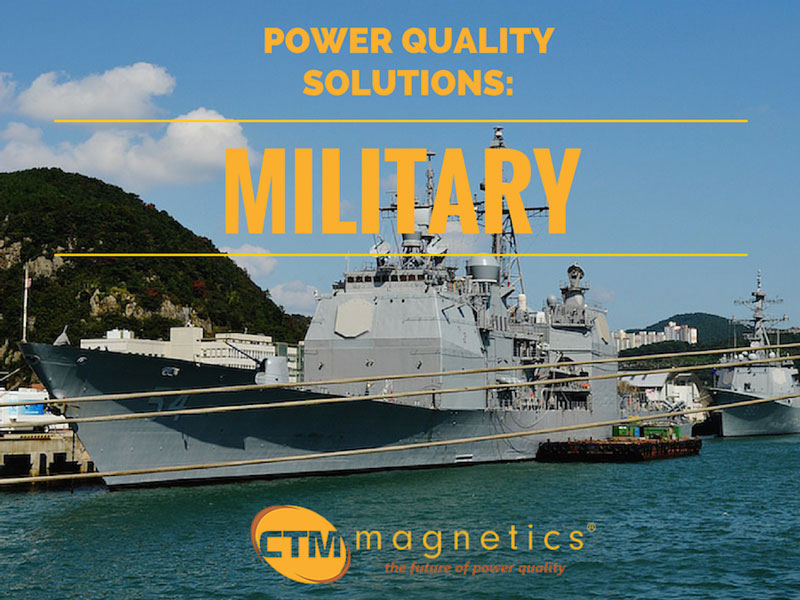Power Quality Solutions: Military
Power quality plays a critical role in operation of almost every type of electrical device, and perhaps no industry segment is more demanding of power quality than the military.
Whether an electrical device is used in a land vehicle, an aircraft, a naval ship or a piece of support equipment, failing to deliver reliable, clean power to the device risks operation failure - and sometimes, human life. Power quality in military applications is critical.

Increasing electrification of military combat and support vehicles is leading to a boom in power quality demands and solutions. With increased electrification comes the need for protection of critical systems. These protection stipulations are often incredibly demanding, with design conditions and constraints not typically seen in civilian applications. Tight space requirements, high shock and vibration specifications, and atypical electric conditions typify military designs.
Military device designs often call for sine wave filters, reactors, and other custom power conditioning solutions. These solutions frequently need to be delivered in environmentally sealed packaging that protects against the harshest environments. Reactors, used both on the supply side and the load side of a device, are among the most commonly used power conditioners.
Reactors
Reactors, or inductors, are passive electrical components which resist changes in electric current. An inductor consists of a conductor generally wound into a coil pattern, usually around an iron or ferrite core. As electrical energy flows through a reactor, a magnetic field is generated that temporarily stores energy. The coil holds a current that changes in AC power applications; when this happens, the magnetic field creates a voltage that opposes the changing current.
Liquid Cooling in Military Applications
From a design standpoint, the physical size, weight and heat produced by a reactor needs to be considered. Heat production is of particular concern because extreme heat is the enemy of power electronics. Natural convection may offer sufficient cooling for small reactors operating at modest current and voltage levels, while forced-air cooling becomes more beneficial at higher power levels.
However, when physical space is limited and thermal conditions are extreme (as is often the case in military applications), liquid cooling delivers the ultimate solution for power density and thermal management.
- Liquid cooling is more efficient than air cooling. The thermal conductivity of water is about 24 times greater than that of air, meaning heat is more rapidly transferred to water. With this increased thermal efficiency, liquid cooled components run cooler and more efficiently than their air cooled counterparts.
- Furthermore, superior heat removal provided with liquid cooling allows smaller magnetic cores to be utilized, further increasing efficiency by decreasing core losses. With smaller cores and compact cooling systems, engineers can design military equipment to a much smaller scale than would be possible using air cooling. On naval ships, especially, space is expensive. Being able to provide clean power and protect sensitive electronics in small spaces is a significant benefit.
- The specific heat capacity of water is more than 4 times greater than air, and the density is about 840 times greater. Combining these factors, a liquid cooled system with equivalent power loss and coolant temperature rise would require a flow rate nearly 3,500 times lower than an equivalent air cooled system.
- Liquid cooled components run far cooler than air cooled devices; liquid cooled reactors are inherently more reliable and less prone to need repair or replacement.
- With fully encapsulated magnetics and cooling system, liquid cooled reactors from CTM are fully sealed, protecting them from the harshest environments.
- Cooling a reactor with liquid isolates the heat it generates. Nearly all the heat produced by a high power reactor is transferred directly to the coolant. Typically, only around three percent of heat escapes to the surrounding air, while the remaining 97 percent is carried off by the liquid cooling system, then dissipated through a heat exchanger. This allows heat that would otherwise threaten sensitive electronic components to be isolated and safely dissipated.
- Power density is of special concern in military equipment. Air cooled reactors have extremely hot surface temperatures, so even if the reactor cabinet is properly sized to dissipate excess heat, most components must be located far away from the inductor to protect them from radiated heat. This greatly increases the effective envelope of the reactor, decreasing power density. Due to heat isolation, liquid cooled components have very low surface temperatures (effectively the temperature of the coolant). Therefore, other electronic components can be placed immediately adjacent to a liquid cooled reactor, further increasing power density of the assembly.
In addition to these advantages, reactors that use liquid cooling produce low levels of audible noise, especially in comparison to laminated silicon-steel inductors, which are extremely noisy due to magnetostriction. CTM uses toroid inductors with soft magnetic materials. This combination of geometry and material science greatly reduces audible noise. Additionally, full encapsulation of liquid cooled reactors further dampens any audible noise, allowing stealth-like silence.
Power quality solutions in the military have caused military contractors and manufacturers to incorporate CTM Magnetics' liquid cooled reactors - these are the smallest, most efficient systems in the world. Visit this page for more information on power quality products for military applications.
 " alt="">
" alt="">